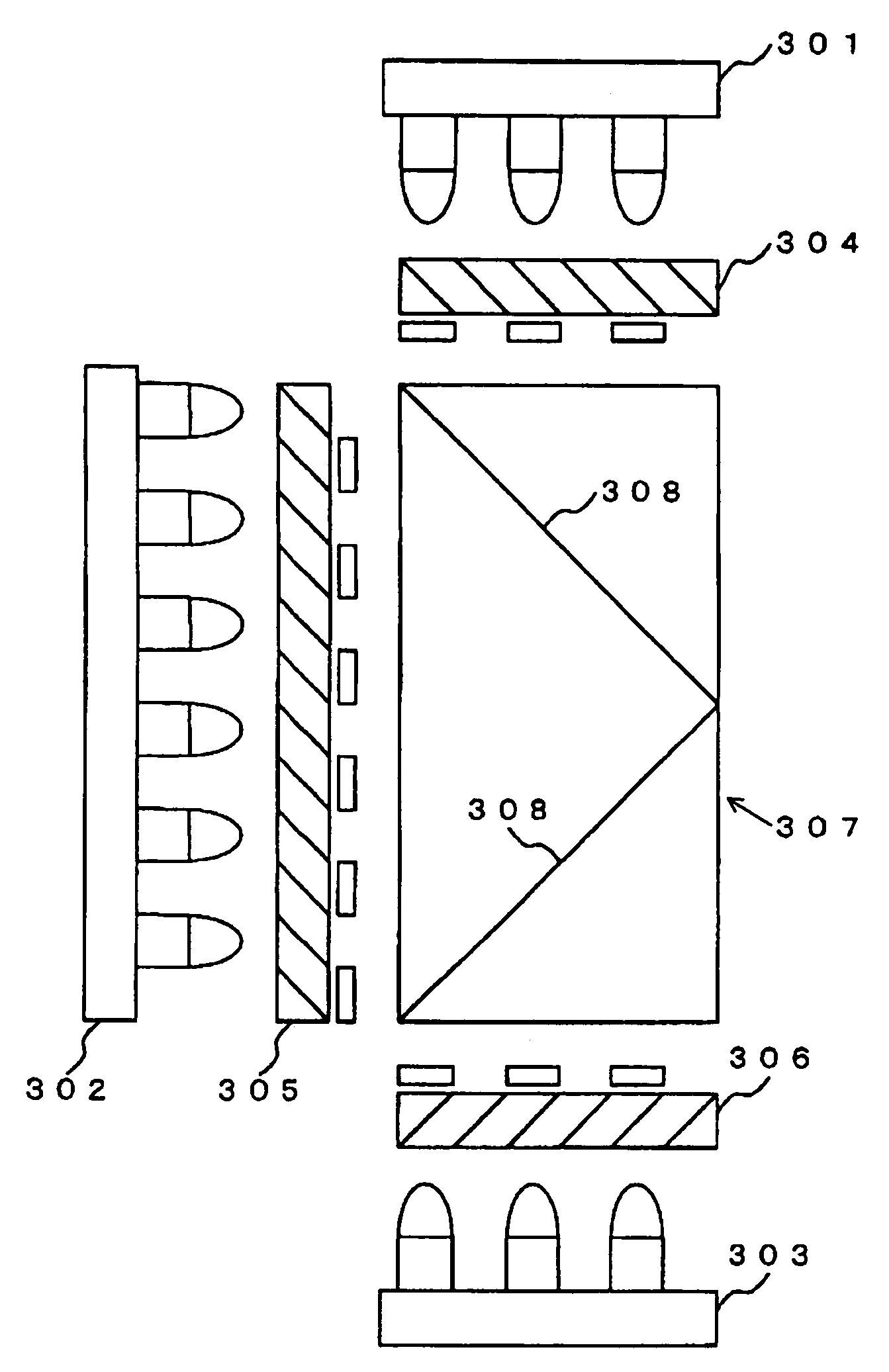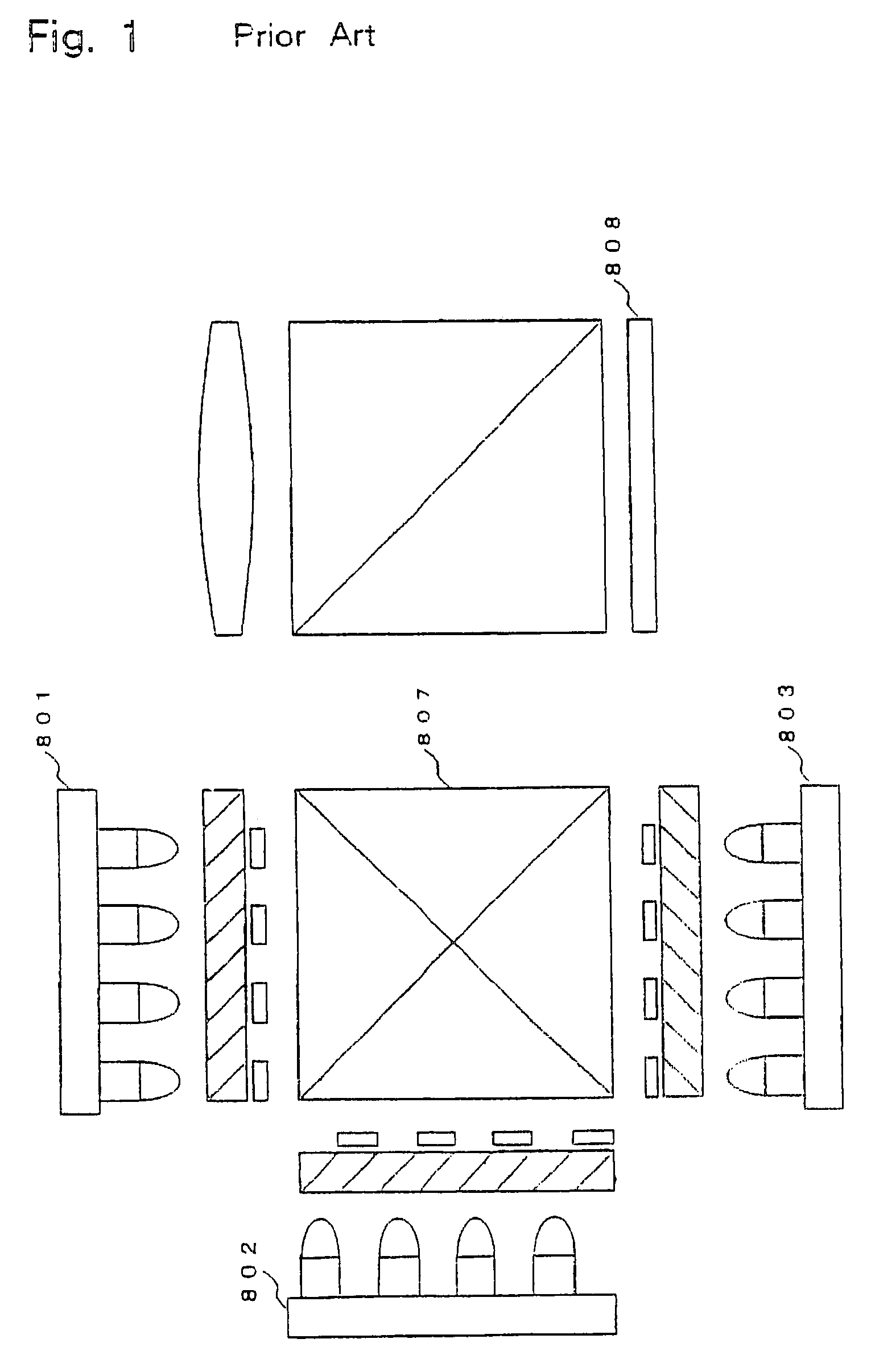Light source device and projection display
a technology of projection display and light source device, which is applied in the direction of projection device, lighting and heating apparatus, instruments, etc., can solve the problems of insufficient light utilization efficiency of display, inability to provide a projection display commercially bright enough for practical use, and difficulty in reducing the size and weight of the overall display, etc., to achieve good white balance and high light utilization efficiency
- Summary
- Abstract
- Description
- Claims
- Application Information
AI Technical Summary
Benefits of technology
Problems solved by technology
Method used
Image
Examples
first embodiment
(First Embodiment)
[0035]FIG. 3 is a schematic diagram illustrating a first embodiment of a light source device. In FIG. 3, reference numerals 101, 102 designate light emission boards on which a plurality of light emitting diodes are two-dimensionally arranged. Reference numerals 103, 104 designate polarized light forming means. Reference numeral 105 designates a polarizing beam splitter.
[0036]Randomly polarized light emitted from the light emitting diodes on light emission boards 101, 102 is uniformly converted to P-polarized light or S-polarized light by polarized light forming means 103, 104 before it is incident on polarizing beam splitter 105. An illumination beam emitted from the light emitting diodes on light emission board 101 and uniformly converted to S-polarized light is reflected on polarized light separation surface 106 of polarizing beam splitter 105, and exits from polarizing beam splitter 105. On the other hand, an illumination beam emitted from the light emitting dio...
second embodiment
(Second Embodiment)
[0042]FIG. 4 is an explanatory diagram for a second embodiment which illustrates an exemplary modification to the light source device described in the first embodiment. The second embodiment differs from the first embodiment in that wire grid type polarizer 205 is used for combining illumination beams from two light emission boards 201, 202 in FIG. 4.
[0043]Known wire grid type polarizers include ProFlux (registered trademark) from MOXTEK Inc., U.S.A., and the like. ProFlux (registered trademark) is a grid type polarizer which has a fine Al grid formed on a glass substrate, which has a width of approximately 65 nm, a height of 100–200 nm, and a pitch of approximately 140 nm, and transmits a polarized light component of randomly polarized light incident thereon in a vibrating direction orthogonal to the longitudinal direction of the grid, and reflects a polarized light component in a vibrating direction parallel with the longitudinal direction of the grid. This type...
third embodiment
(Third Embodiment)
[0045]FIG. 5 is an explanatory diagram for a third embodiment which illustrates another exemplary modification to the light source device described in the first embodiment. The third embodiment differs from the first embodiment in that a light source device in FIG. 5 comprises three light emission boards 301, 302, 303, and polarizing beam splitter 307 having a V-shaped polarized light separation surface 308 for combining illumination beams from three light emission boards 301, 302, 303. The resulting light source device is reduced in volume to one half, and therefore is much smaller than the light source device of the first embodiment which employs polarizing beam splitter 105.
[0046]Randomly polarized light emitted from light emitting diodes arranged on light emission boards 301, 302, 303 is uniformly converted by polarized light forming means 304, 305, 306, respectively, to P-polarized light or S-polarized light which is incident on polarizing beam splitter 307. I...
PUM
 Login to View More
Login to View More Abstract
Description
Claims
Application Information
 Login to View More
Login to View More - R&D
- Intellectual Property
- Life Sciences
- Materials
- Tech Scout
- Unparalleled Data Quality
- Higher Quality Content
- 60% Fewer Hallucinations
Browse by: Latest US Patents, China's latest patents, Technical Efficacy Thesaurus, Application Domain, Technology Topic, Popular Technical Reports.
© 2025 PatSnap. All rights reserved.Legal|Privacy policy|Modern Slavery Act Transparency Statement|Sitemap|About US| Contact US: help@patsnap.com



